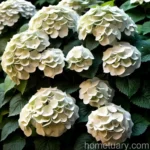The Magnificent Panicle Hydrangea (Hydrangea paniculata)
Hydrangea paniculata, commonly known as panicle hydrangea, is a stunning flowering shrub that has gained immense popularity among gardeners. Renowned for its large and showy panicle-shaped blooms, this plant adds a touch of elegance and charm to any garden or landscape. In this comprehensive guide, we will explore the various aspects of this delightful plant, including its culture, uses, care requirements, common diseases and pests, as well as propagation techniques. Whether you are an experienced gardener or a novice enthusiast, this article aims to equip you with the knowledge and expertise needed to cultivate and enjoy the beauty of panicle hydrangeas to the fullest.
What is Panicle Hydrangea (Hydrangea paniculata)?
Plant Description
Panicle hydrangea, scientifically known as Hydrangea paniculata, is a deciduous shrub that belongs to the Hydrangeaceae family. Originating from East Asia, particularly China and Japan, this plant is characterized by its large, pyramid-shaped flower clusters, or panicles, which typically emerge in mid to late summer. The flowers initially appear creamy-white and gradually transform to shades of pink and eventually deep russet as the season progresses. The stunning blooms often persist well into the fall, adding an appealing aesthetic to the garden even during the latter part of the year.
With a strong, but graceful, upright growth habit, panicle hydrangeas can reach heights of 6 to 10 feet, making them an ideal choice for creating hedges, screens, or standalone ornamental specimens. The foliage of Hydrangea paniculata consists of dark green, ovate leaves that provide an attractive backdrop to the magnificent floral display.
Key Takeaways – Panicle Hydrangea (Hydrangea paniculata)
Before delving into the specifics of panicle hydrangea care and cultivation, it is beneficial to highlight some key takeaways about this remarkable plant. This overview serves to provide a comprehensive understanding of the plant’s characteristics and requirements, enabling gardeners to tailor their approach to suit the unique needs of panicle hydrangeas.
Culture
- Scientific Name: Hydrangea paniculata
- Common Name: Panicle Hydrangea
- Family: Hydrangeaceae
- Origin: East Asia (China, Japan)
Uses
- Ornamental Purposes: Landscaping, garden borders, standalone specimen, hedges
- Cut Flowers: Panicle hydrangea flowers are often used in floral arrangements and bouquets due to their striking appearance and long vase life.
Water
- Watering Needs: Moderate; consistent moisture is crucial, particularly during the flowering period and hot, dry spells. Well-draining soil is essential to prevent waterlogging, which can lead to root rot.
Sunlight
- Light Requirements: Prefers full sun to part shade. In hot climates, some afternoon shade can be beneficial to prevent excessive wilting and sunburn.
Fertilizer
- Fertilization: Apply a balanced, slow-release fertilizer in spring to support healthy growth and abundant blooming. Avoid excessive use of high-nitrogen fertilizers, as they can promote lush foliage at the expense of flowers.
Soil
- Soil Type: Well-draining, loamy soil with a slightly acidic to neutral pH. Amending with organic matter can improve soil structure and fertility.
Pruning
- Pruning Time: Late winter to early spring before new growth emerges. Remove spent flower heads to promote new growth and maintain a pleasing shape.
Propagation
- Propagation Methods: Softwood cuttings, hardwood cuttings, and division. Softwood cuttings are typically taken in early summer, while hardwood cuttings are best obtained in late autumn or early winter.
Container Popularity
- Suitability for Containers: Panicle hydrangeas can be successfully grown in large containers or pots, provided they receive adequate care and maintenance. Container growth may require more frequent watering and fertilization.
Common Diseases
- Disease Susceptibility: Panicle hydrangeas may be vulnerable to fungal leaf spots, powdery mildew, and various stem and root rots. Proper cultural practices and vigilant monitoring can aid in preventing and managing these issues.
Disease Diagnosis
- Signs of Disease: Leaf spotting, yellowing, wilting, or fungal growth on leaves and stems. Stunted growth and decline in overall vigor can also indicate underlying disease problems.
Common Pests
- Pest Threats: Aphids, scale insects, and spider mites can infest panicle hydrangeas, causing damage to foliage and compromising plant health. Regular inspection and integrated pest management strategies are essential for pest control.
Botanist’s Tips
- Expert Advice: Enriching the soil with compost and organic matter is beneficial for panicle hydrangeas, as it enhances soil fertility and moisture retention. Applying a layer of mulch around the base of the plant helps in conserving soil moisture and regulating soil temperature.
Fun Facts
- The flower color of panicle hydrangeas can be influenced by soil pH, with acidic soils promoting blue hues and alkaline soils favoring pink tones.
- Panicle hydrangeas are valued for their hardiness and resilience, thriving in a wide range of climates and soil conditions.
Links to External Resources
Now that we have established an overview of the panicle hydrangea and its key aspects, let’s delve deeper into each of these elements to gain a comprehensive understanding of how to care for and appreciate this magnificent plant.
In order to keep the information organized and to maintain readability, the content will continue in a response to this message.















